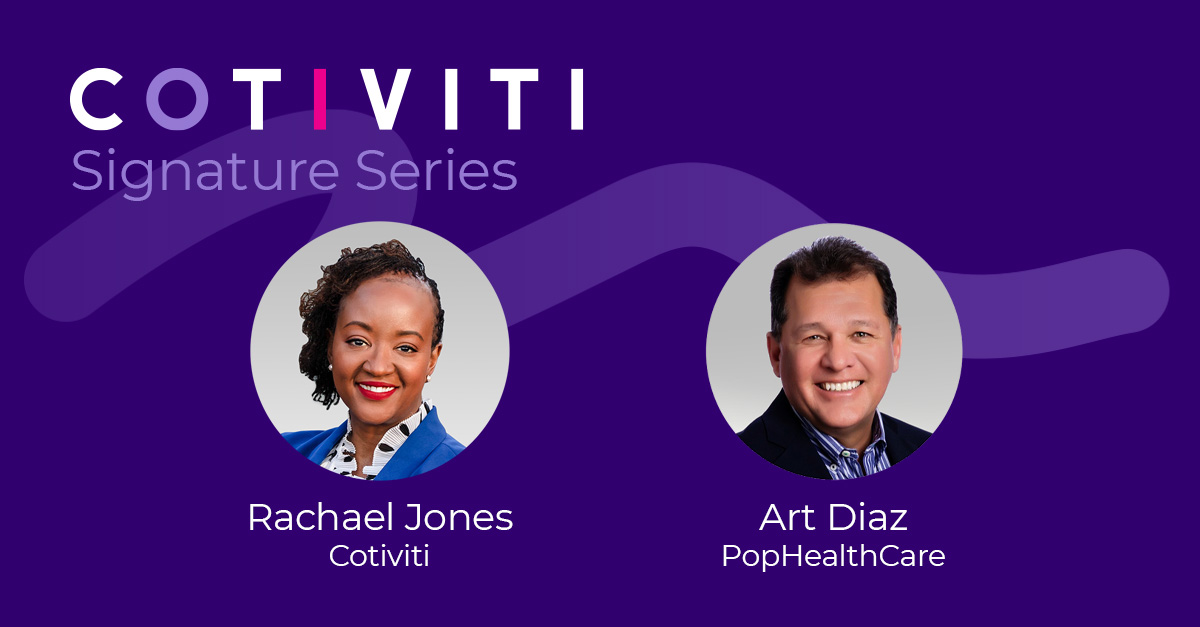Cotiviti's Signature Series features interviews with senior healthcare industry leaders on how to improve clinical and financial outcomes in healthcare.
The COVID-19 pandemic served to accelerate healthcare trends and has led many payers to reevaluate how they engage members in meaningful ways that will ultimately result in better outcomes. By working in unison, risk adjustment and quality teams can better understand where care gaps exist and the most effective ways to deliver high-value care to disengaged or disenfranchised members.
What strategic initiatives meet at the intersection of risk and quality? We dove into this topic during a recent discussion with Art Diaz, chief operations officer for Risk Adjustment at PopHealthCare, and Rachael Jones, senior vice president of Performance Analytics and Quality at Cotiviti. This discussion focuses on recent trends in telehealth utilization, in-home assessments, their influence on both risk and quality programs—and how this impacts health plans as they set future strategies.
How do you define the intersection between risk and quality?
Art Diaz: There's an uncelebrated relationship between risk adjustment and quality. We tend to view risk adjustment as a monetary-driven, financial activity and quality as a care-driven activity. But from a risk adjustment perspective, the intersection between risk adjustment and quality initiatives drives much of what we see reflected and celebrated in quality.
For example, let’s take in-home assessments. The HHS Office of Inspector General (OIG) reported in September of 2020, that approximately 1% of calendar year 2017 Medicare Advantage payments are uniquely attributable to in-home assessment programs, and about 15% of the entire Medicare Advantage population received an in-home assessment with no other encounter. However, it is through these risk adjustment activities, specifically the proactive outreach to disenfranchised members, that we're able to engage these chronically ill members, assess these members, and provide education.
As we perform comprehensive in-home assessments at PopHealthCare, we spend a good amount of time educating members about their identified conditions. And since PopHealthCare also provides full care services for managing frail and complex members, we can partner with health plans in supporting the members identified conditions. The net effect of this intersection between risk adjustment and quality is proven in the benefits and value delivered to the approximately 40% of the Medicare beneficiaries joining a Medicare Advantage plan. And the decision to join the Medicare Advantage plan often comes at no additional cost to the members. And that’s where that cost-effective care achieves amazing quality ratings—close to 80% of all Medicare advantage members are in a four-star or higher plan. So, this push to engage members, whether it's through risk adjustment or quality, is adding value by means of high-quality care delivered at a reasonable investment to the public purse.
Meet the challenge of in-home assessments and telehealth with Cotiviti's Prospective Risk Adjustment solution.
Rachael Jones: I agree. I think about this intersection of risk and quality through the lens of aligned incentives. We know that prior to the pandemic, about 50–75% of organizations were still paying in that fee-for-service model, and we've had a hard time moving from fee-for-service to value. I think the opportunity lies ahead as to how we break down what each of those parts are about. Risk adjustment and risk accuracy are about ensuring that the reimbursement for each member is sufficient or matches the intensity of that care. And quality is about making sure that we are documenting that those doctor visits occur, that the right treatment occurred, and that we're actually seeing the outcomes realized from the appropriate care that's being delivered to the member.
Putting the member at the center and overlaying the foundation of risk and quality with aligned incentives allows us to broaden the conversation and collaborate with providers to explore opportunities to improve overall health and risk accuracy. And in doing so, we create a greater financial incentive, ensuring everybody is working toward the same goals.
We see that many plans use in home assessments at the end of the year. What are the advantages of having in-home assessments as part of a yearlong patient engagement data capture strategy?
Art Diaz: I think using in-home assessments in the fourth quarter is a reactionary type of thinking. It’s the thought process of having members that you suspect have a condition that has not been diagnosed this year, and then quickly diagnosing them in the fourth quarter before the year comes to an end. But our approach at PopHealthCare is a year-round view. We have enough data and experience to know that for certain members there's no need to wait until the fourth quarter, and that they may have already seen a provider but they haven’t been adequately reviewed, assessed, and all conditions documented and submitted to CMS. In those cases, we already know that we'll start seeing those members in the first quarter or the second quarter.
There are also certain attributes to look out for, such as knowing that the member has a cadence to seeing their provider. Maybe they see their provider every third year, or they skip years. We learn these behaviors through the data that we have available. We analyze our assessment of these members within the continuous year-round cycle, not just focusing on the fourth quarter.
Where is the intersection between a year-round timeline and how it impacts providers under risk-based contracts?
Rachael Jones: What we're seeing is that we're moving beyond doing these things as a push to more of a year-round focus because member care happens every day. It's therefore important to look at the data coming in and support our clients with year-round quality measurement and quality insights. Many of our clients will take that data and push it into value-based programs, either from a measurement standpoint or an educational standpoint. There's a great opportunity here to educate providers on what the opportunities are to improve care year-round.
Another benefit to this year-round approach is that it gives members top-of-mind awareness about their role in actively managing their health. When providers and members both work together to achieve optimal outcomes, we have the best of both worlds. In that situation, everybody has a chance to win.
How has COVID-19 impacted your part of the business and how does it influence this intersection that we're talking about?
Rachael Jones: “Unprecedented” is the word that people like to use to describe 2020, but in every crisis, there is an opportunity. And while we know there was significant disruption in patient care in the early stages of the pandemic, especially when we weren't clear on the protocols for safety, I think two things emerged.
The first was that providers who enrolled in value-based care programs were able to have continuity in their revenue flow. We saw health plans giving advanced payments or upfront payments to help sustain providers who are in value-based arrangements to continue to provide patient care as their fee for service revenue went down.
The other exciting thing that emerged was technology and telehealth coming to the forefront. In the past decade it's been more on the fringes, but when it became the only option, many of those non-life-threatening needs were able to be met through telehealth. And for members with chronic diseases like diabetes or COPD, having a regular check-in with their providers via mobile or other devices was a vehicle that was used quite a bit in the pandemic and why I'm excited to see if the reimbursement models shift in response to that.
There is now a much broader acceptance for how effective telehealth can be in helping to maintain, monitor and check in with those members and to continue the dialogue. We have been impressed and excited at how creative the industry was in responding to the pandemic and using technology and other modalities of care to ensure that we didn't miss a beat in providing member care and driving optimal outcomes.
During the pandemic, healthcare organizations had to pivot quickly to performing telehealth visits. How did you handle that?
Art Diaz: We didn't have to pivot quickly at PopHealthCare since we had been using telehealth for several years in our management of high-risk members through our care management programs. Telehealth was always a tool that we had and when we implemented our solution it already was HIPAA compliant. What we did find, however, was a substantial surge in the volume of telehealth work.
When we thought about telehealth for the in-home assessment business, we sat down with our PopHealthCare clinicians that have been doing in-home assessments for many years. We asked, what percentage of conditions will we be able to evaluate via telehealth compared to in-person? These clinicians came back to us saying that we could evaluate about 90% of the conditions. At the end of 2020, we found that we diagnosed the same conditions through telehealth as compared to the 2019 in-person assessments. We evaluated members largely in the same manner as in-person—telehealth really allowed us to be able to engage our members.
CMS released a statistic that in 2020, 44% of Medicare primary care visits were provided via telehealth in April of 2020 compared to 0.1% in February, just two months earlier. Talk about a ramp up! For Medicare, the data are now showing that as provider offices are opening up, members are migrating back into the office, but there's still a sustained level of telehealth. Telehealth is something that we're going to be able to leverage and use for years to come. And it will continue to grow as the population gets more comfortable using telehealth.
Rachael Jones: I couldn't agree more, especially as we look at the landscape and we see more and more big tech jumping into healthcare. Between Apple and Amazon and all the other organizations getting into this space, it’s no surprise considering how far we’ve come in in technology advancement. We can order our prescriptions and have a FaceTime chat with our physician. We can take a picture of an ailment and send it off. All these developments are putting us at an important inflection point.
Many healthcare organizations are still playing catch-up due to the disruptions made by the COVID-19 pandemic to regular care and filling documentation gaps that may have occurred over the course of the past year. Cotiviti’s Prospective Risk Adjustment can help your organization get up to speed. Prospective Risk Adjustment addresses gaps in both documentation and care, while also identifying conditions that are likely to exist but have not been coded. Learn more by downloading our fact sheet.






